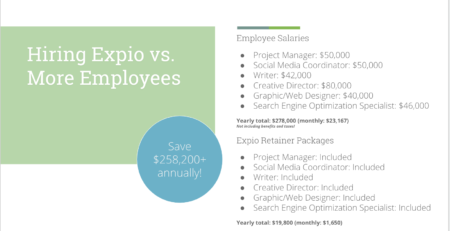How to Create an Editorial Calendar
The experts at Expio Digital Marketing explain why your business should be using an editorial calendar to stay organized.
What is an editorial calendar?
An editorial calendar is a virtual workflow that allows those in the publishing industry to coordinate tasks among writers, editors and other publishing roles from the time of assigning a project until its deadline. In simpler terms, an editorial calendar is a schedule of the content that you want to post, plan to post and need to post. Editorial calendars are typically used by magazines, book publishers, newspapers, newsletter creators, social media professionals and content websites. They are a good way to organize your thoughts and make sure you’re not missing relevant information that could pertain to your audience.
Why use an editorial calendar?
Editorial calendars are the easiest way to make sure you’re posting the content that you need to. For example, it’s important for medical brands, such as OBGYNs, to post breast cancer awareness content on their social media channels, blogs and email blasts during October each year.
Editorial calendars are a good way to stay organized. Depending on the tool you use to create your calendar, you can assign roles and deadlines for each task, creating a color-coded key and choosing a format that fits your team’s needs. They’re also key for transitioning and consistency. If your social media management team experiences role changes, new team members need only follow the calendar for direction and brand consistency.
Team members can consult editorial calendars multiple times a month. Use them as a guide as you schedule your social posts and blog/email blast assignments for the month, and review them once or twice during the month to make sure nothing has been missed.
What are important things to consider when making an editorial calendar?
It’s important to consider your business’ goals, as well as how much and when you want to post to social, blogs and email. Consider your post variety, so your audience stays engaged. Adhere to an 80-20 rule of fun versus marketing. This means 80-percent interaction, news, blog posts and other fun, helpful posts mixed with 20 percent calls to action that get people to really react to a company’s services. The 80-percent interaction establishes trust and confidence in the brand. Handing out great free content, like helpful blogs and white papers, helps customers decide to react to an invitation to do business.
What content is recommended to be included in editorial calendars?
Add important business deadlines, event dates, seasonal topics and promotions. Include fun memes, testimonials and links to great information on your website. Include a section for notes and future post ideas.
Which types of businesses benefit from an editorial calendar?
Any business using a content strategy should have an editorial calendar. They’ll keep your team organized and keep your important digital marketing tasks at the forefront.
What are steps to take to create an editorial calendar?
The first step is deciding on a platform. You can use a shared spreadsheet or choose from a variety of third-party solutions, like Trello or a project management tool. Next, break out your months and weeks for the full year, and start plugging in national holidays, national days of the week, seasonal promotions, events, etc. Use keyword research to drive your content ideas. Some keyword phrases have more search demand at certain times of year, so capitalize on those search terms by scheduling relevant content.
Consider your editorial calendar a working document, always in review. Holidays and national days of the month sometimes change from year to year, and your event dates and promotions will vary. So, schedule time to refresh your editorial calendar every few months.






Leave a Reply